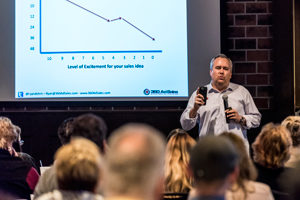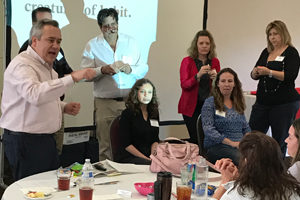Are Customer Needs Assessments Dead?
Are Customer Needs Assessments Dead?
As we navigate the changes in our world right now, I think it’s important to focus on the Customer Needs Assessment as a part of my corporate sales training blog.
If you’re in a leadership role, right now you might be saying, “No, Ryan, don’t talk about not doing a CNA.”
Here’s my point, though. We’re living in a world where people are limited in cash, limited on funds, and certainly limited on patience. For the most part, I think everybody right now is actually limited to some degree in their cognitive abilities. So how do we expect someone we’re selling to to actually understand what they need vs. what they want?
Think about this regarding the Customer Needs Assessment. Very often it focuses in on what they want, and not what they need. Think about all the questions you ask. “What’s your budget?” “What are your goals?” “What keeps you up at night?” “What’s the biggest business challenge for you?” “How can we help you overcome that?”
It’s all focusing on what they want. They want paying customers, they want new business, they want to retain business. Want, want, want.
It really should be called the Customer Wants Assessment, right? Think through this with me before you shut down on the idea. Be open-minded. I sell every day, just like you do. I’ve been in sales and marketing for 30 years. I didn’t stop selling to become a consultant; I love the sales business.
So here’s a radical idea: Maybe we need to find our joy in that, in the sales business.
So this Customer Needs Assessment, where we ask them what they need—it really focuses on what somebody wants. So if we don’t actually guide them toward what they need, they’re going to come back to us in the coming weeks or months and say, “I didn’t get any ROI.” They didn’t get the return on investment that they needed. And so a lot of the time they didn’t get what they needed because we gave them what they wanted.
So here’s what I want you to consider in addition to the CNA: putting forth powerful recommendations.
Let me give you some background on my thoughts here.
There are a lot of impatient people out there right now. How many of you feel cranky right now? I feel cranky. I’m cranky about the world, I’m cranky about politics, I’m cranky about COVID. I’m just cranky. And it’s difficult to deal with cranky people you’re selling to. They try to tell you what they want, and you’re trying to convince them what they need, so I’d like to talk to you about recommendations instead.
Were you aware that Nielsen, the TV ratings and audits company, reports that recommendations are the most trusted form of information? This is a tool we can use as salespeople, and this is something I stress in my sales training. We can coach our customers on why they need something, and what they need to buy. And then we can get them to a point where we not only fulfill their wants, but we actually get to the heart of what they need.
Harvard Business Review had a review of 600 top sales professionals, and here’s what they found out: Most sales reps rely on a customer to coach them through the sales process. Now, the superstar sales reps that I work with in my sales training, we coach the customer. We know the questions we need to ask the customer to find out what it is they truly need beyond what they want.
But still, most customers are going to struggle to identify an exact need. For example, they might say, “I need more customers.” So I may say, “When you say ‘customers,’ can you be more specific? Tell me more. Give me some detail about that.”
So, to guide customers to a recommendation, I’m doing a great deal of comparative selling.
Creating a comparative conversation helps you draw out ego, helps you draw out emotion, and helps you draw out logic.
Sometimes in the advertising business, where I spend a lot of my time, I’ll say things like, “Who do you feel does a great job of marketing here in our community?” I suppose they could say, “Nobody does.” But typically they give an example of somebody.
And then I’ll say, “Do you want to be like them, better than them, less than them? Do you want to be competitive with them, or do you want to dominate them?” I work to determine what’s the circumstance for them.
What I don’t ask them is what their budget is. Because if you ask them what their budget is, they’re probably going to give you a number based on their reality. Not the reality of marketing in the community where you live.
My next tool to guide customers to a recommendation is sharing success stories through comparative selling.
Let’s say, for example, that you sell in the software space. When you create a comparative conversation, you’re actually comparing the customer that you have on the phone to other customers that you’ve had in the past that are very, very happy.
Here’s an example. When I sell, I ethically share stories about my current clients. I share what they love about me, what they love about the software, what they’ve loved about the company, what they’ve loved about the experience–and I can begin to compare customers.
I use these comparative conversations so I can recommend products based on the happiness of other customers, realizing that other customers’ happiness will oftentimes translate to the happiness of this new customer that I’m trying to get.
It’s easy—and it’s all about sharing success stories.
But sometimes we salespeople don’t like to do this, and the reason we don’t is because we feel like we’re talking about a customer behind that customer’s back. But we’re not. What we’re actually doing is shouting from the mountaintop how happy other customers are with us.
And if they’re happy, then this new customer probably will be, too. And happiness is ultimately what we’re seeking.
Now, you might get really technical about this, and you might say, “Well, Ryan, I’m not looking for happiness, what I’m looking for is making sure they have the ROI that they demand.” But I am here to tell you, when push comes to shove what most people want to do is what others have done to be successful.
Just last weekend I was talking with a friend of mine. She said, “I’m having some great luck losing weight.” I said, “Cool! I would love to drop 15 pounds. I think it would make me happy and make my wife happy. What are you doing?”
And she told me about her weight management plan. So I immediately went home and looked it up online to find out how I could get involved in this.
The point is, her success story led me to make a great buying decision, for me. This is a simple buying example, but it can resonate through everything you do.
Consider that when you have a linear conversation, a one-way conversation with a client, what you do is keep them inside their own bubble. And it’s not until somebody gets out of their bubble—OUT of it—that they realize, “Oh, other people out here are happy, they’re being successful, and I want to be like them. What are they doing? What is their weight loss plan? How did it work for them? What made them happy?”
As a salesperson, if I can help customers be happy—happy like other people–then all of a sudden they start buying what it is that I’m selling. It’s a simple sales concept that works and that resonates with customers.
I’ve had the opportunity to walk through and be a part of almost every sales training program in America, from Carnegie to Sandler. And a problem I see is that they focus on a one-way conversation where you identify somebody’s pain and then you fix that pain.
That’s great in theory, but as a salesperson you can actually take it to the next level by telling them about other happy customers whose pain you have eliminated. It’s about proving that you have done something for other people.
It’s about getting beyond the old fashioned Customer Needs Assessment to start recommending products, sharing success stories, and creating comparative conversations.
And remember, in these conversations, be mindful of the questions that you ask. Make sure those questions take you to a better place.
So, what are the questions?
I try not to ask the same questions that have been asked for the last 10-15 years, the ones that make you sound like all the other salespeople that have shown up either face-to-face, on Zoom, or on the phone.
I strive to ask the questions that other salespeople don’t. In that vein, I don’t ask, “What keeps you up at night?” I would rather ask a question, something along the lines of, “If we could help bring you one perfect customer, what would that customer look like?”
Or, “When you agreed to meet with me, was there a business challenge you were hoping that I could help you solve?”
I’ll say it again, rather than asking, “What’s your budget?” … especially in the ad sales world where I spend a lot of my time in the advertising business, I’ll say, “If we could help you be bigger and better than your nearest competitor, what would that look like?” “In the past, what have you done to solve these types of problems?”
Or I might use something back from my good old Sandler days like, “What is the biggest challenge that you’re facing right now that you think I can help you solve?” Or “How long has that been a challenge or a problem for you?” “What have you done in the past to fix that problem or remove that problem from the greater equation of your business?”
When you ask your questions, remember these ideas I espouse in my sales training programs: Most people want to be led. Most people like recommendations. Most people don’t like a linear conversation—they want to know what others are doing and what you have done to help other people.
So, in closing, the Customer Needs Assessment isn’t dead, necessarily, but if we don’t breathe some new life into it, if we keep doing the same thing we’ve always done, we’re going to get the same result. If we want to see a different result, we’ve got to do something different.
That’s why we’re advisors … try to be an advisor, don’t be a salesperson. Breathe some new life into your Customer Needs Assessment.
And managers out there—sales directors, sales leaders—look at the questions your salespeople are asking prospects and customers. Make sure that they’re updated. Make sure they reflect the current situation that we’re in.
Then finally, always remember. If sales was easy, everybody would be doing it. And they’re not. So we’re either crazy or we’ve found a career that will feed our families for a lifetime.
About this blogger:
Ryan Dohrn is an award winning sales coach and offers sales training to thousands of sales executives each year. He is also an international motivational speaker and the author of the best-selling sales book, Selling Backwards. Ryan is the President and founder of Brain Swell Media, a boutique sales training and sales coaching firm with a detailed focus on sales training and sales coaching for companies in 17 unique industry sectors from media to tech to aviation. He is also the owner and Publisher of SalesTrainingWorld.com an online portal for sales training success.
Contact information:
Ryan R. Dohrn
President/Founder, Brain Swell Media LLC
Publisher, SalesTrainingWorld.com
Ryan@BrainSwellMedia.com
http://www.BrainSwellMedia.com
Follow him on Twitter.com/ryandohrn for daily tips and advice.
http://www.linkedin.com/in/ryandohrn
###



